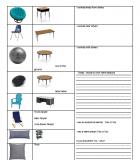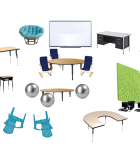Leigh Ann Pullen
Special Education Teacher
Washington Henry Elementary School
Hanover County Public Schools
The Need and Impact of Focused Lessons
and Reflection in Student Choice Environments

“There once lived eight very sad students who went to school and every day they sat at the same old desks, and in the same old chairs. They constantly moved around in their seats, and stared off thinking, “Oh if only I could move around.” “If only I could sit in a more comfortable chair,” “If only I could move away from distracting students,” “If only I could stand,” “If only I could have a break,” “If only I just had CHOICES!” Well, it just so happened that there was a teacher who found a way to make all these dreams come true:”
Over the past eight years I have taught both General Education and Special Education, including grades kindergarten through fourth grade, for Fairfax and Hanover County Public School Systems. I currently teach Special Education at a school with less than 500 students that has become more transient and is currently landlocked with no new construction feeding into it. There has been an increase in the number of students who are provided with free and reduced lunch; as well as, the number of students receiving Special Education services. The above story, is a true one about my current students. Their feelings and quotes, though written as fiction, are very much real. Many teachers I have observed and work with may provide choices but within given constraints such as “you may sit at your desk or that table.” Students do not have ownership of where or how they work, and are not given opportunities to learn and articulate what they need. At the same time, each year more and more teachers seem to have more concerns about the attention and motivation of their students. This sparked the original question of what is the impact of intentional choice work areas on attention and motivation of eight students, with an Other Health Impairment due to attention and/or a Specific Learning Disability, in the self contained Language Arts setting? For the sake of this research, intentional choice work areas refers to multiple seating options and work areas that students choose, based on how it impacts their attention and motivation when independently working.

This year students have had the opportunity to have an environment that allows them choice, focused lessons, and group discussions when they are in my self contained setting. The first action research cycle focused on the problem of the need to address attention and motivation of students in relationship to their learning environment. At the beginning students could sit wherever and with whoever they liked.
Data revealed 63% of students typically chose to sit on a ball and of those students, 20% stated they sat there because it was cool, while the remainder sat there because it was comfortable and near friends. 1 student reported their attention was not so great, 3 reported ok, 2 reported attention was good, and 2 reported great. 2 students reported their motivation was not so great, 3 ok, 2 good, and 1 great.
Lessons were then provided with an emphasis on Awesome Learners and Team Players. An Awesome Learner is a student that tries their best, stays focused to the best of their ability, and gets work completed in a timely manner. Team Players are not distracting to the best of their ability, allowing others to be successful. Students filled out reflection forms and student interviews were conducted. After the second and third cycles it was very apparent that reflections and focus lessons when paired with student choice environments, had more positive impact on student behaviors, attention and work completion than just the environment and choice itself, for these students. The reflection sheets did not necessarily impact motivation but had a big effect on attention and helping students make good choices. The data also showed that when the reflection sheets were provided at the beginning of the class it had a more positive impact on attention and students making good choices, compared to at the end. Students’ ability to choose where they sat was motivating for them and helped them attend and make good choices, with a focus on moving when they needed to and the ability to work away from peers. When the reflections and lessons were taken away in cycle 2, student behaviors reverted back to match the baseline data. They chose where they wanted to sit because of their friends and liking the exercise balls.

In the last cycle students were taught about advocacy and how to articulate what they need and want to be able to learn, inclusive of their environment. With the reflections and lessons were paired with student choice in the environment, the number of students making good choices, completing work, and attending to task increased. Students started making choices to work in different locations, utilizing different furniture options, articulating what they needed and how they needed to work.
“At the close of the year, the eight fabulous students learned to be amazing advocates for their learning and environment. They were no longer sad and each day came to school ecstatic to learn.”
In Cycle 4 the class worked collaboratively to create a book that is being published for us by Scholastic that shares our story this year and the impact that this research has had. Many students bought the book and one will be provided for all teachers in the school to access. Activities to go along prior to reading, during the reading, and after the reading were added at the back of the book to help teachers change their classroom environments and communities.
